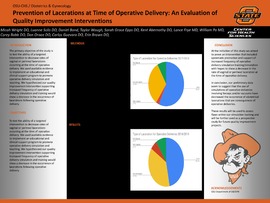| dc.contributor.author | Wright, Micah | |
| dc.contributor.author | Solis, Luanne | |
| dc.contributor.author | Bond, Daniel | |
| dc.contributor.author | Waugh, Taylor | |
| dc.contributor.author | Epps, Sarah Grace | |
| dc.contributor.author | Abernathy, Kent | |
| dc.contributor.author | Frye, Lance | |
| dc.contributor.author | Po, William | |
| dc.contributor.author | Babb, Corey | |
| dc.contributor.author | Oraee, Dan | |
| dc.contributor.author | Guevara, Carlos | |
| dc.contributor.author | Brown, Erin | |
| dc.date.accessioned | 2020-04-14T16:12:38Z | |
| dc.date.available | 2020-04-14T16:12:38Z | |
| dc.date.issued | 2019-02-22 | |
| dc.identifier | ouhd_wright_preventionoflacerations_2019 | |
| dc.identifier.citation | Wright, M., Solis, L., Bond, D., Waugh, T., Epps, S. G., Abernathy, K., Frye, L., Po, W., Babb, C., Oraee, D., Guevara, C., & Brown, E. (2019, Feb. 22). Prevention of lacerations at time of operative delivery: An evaluation of quality improvement interventions. Poster presented on Research Day at the Oklahoma State University Center for Health Sciences, Tulsa, OK. | |
| dc.identifier.uri | https://hdl.handle.net/11244/323877 | |
| dc.description.abstract | Objective: To test the ability of a targeted intervention to decrease rates of vaginal or perineal lacerations occurring at the time of operative delivery. We used available evidence to implement an educational and clinical support program to promote operative delivery simulation and teaching. We hypothesized our quality improvement intervention supporting increased frequency of operative delivery simulation and training would show a decrease in the occurrence of lacerations following operative delivery. | |
| dc.description.abstract | Methods: We are conducting a retrospective cohort study following the implementation of our quality improvement initiative promoting more frequent operative delivery simulations and training to assess the association with a decrease in vaginal or perineal lacerations at the time of operative delivery. This quality improvement initiative was instituted at our academic care center in 2018. The program included a needs assessment, simulation of operative delivery, online educational material as well as expanded core outcome documentation following operative deliveries. We analyzed rates and types of operative vaginal delivery birth in pregnancies at or beyond 35 weeks of gestation without a contraindication to operative delivery. We also analyzed rates of vaginal or perineal lacerations occurring after operative vaginal delivery using both vacuum and forceps instrumentation. | |
| dc.description.abstract | Aim Statement: "To evaluate if increasing the frequency of operative delivery simulations of both forceps and vacuum delivery along with education to prevent perineal lacerations will show an associated decrease in vaginal or perineal lacerations during the time of operative delivery." | |
| dc.description.abstract | Conclusions: We aim to prove an intervention that included systematic promotion and support of increased frequency of operative delivery simulation training/simulation is associated with an decrease in the rate of vaginal or perineal laceration at the time of operative delivery. | |
| dc.format | application/pdf | |
| dc.language | en_US | |
| dc.publisher | Oklahoma State University Center for Health Sciences | |
| dc.rights | The author(s) retain the copyright or have the right to deposit the item giving the Oklahoma State University Library a limited, non-exclusive right to share this material in its institutional repository. Contact Digital Resources and Discovery Services at lib-dls@okstate.edu or 405-744-9161 for the permission policy on the use, reproduction or distribution of this material. | |
| dc.title | Prevention of lacerations at time of operative delivery: An evaluation of quality improvement interventions | |
| osu.filename | ouhd_wright_preventionoflacerations_2019.pdf | |
| dc.type.genre | Presentation | |
| dc.type.material | Text | |
